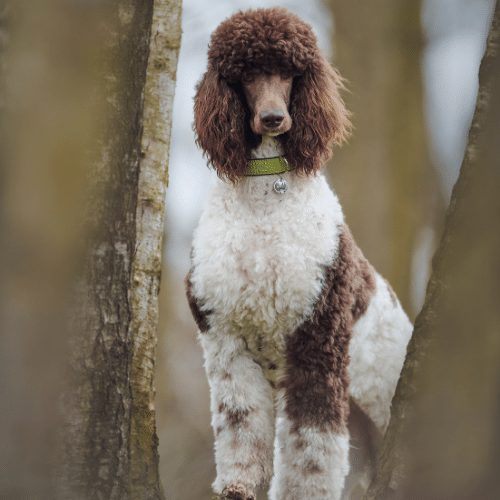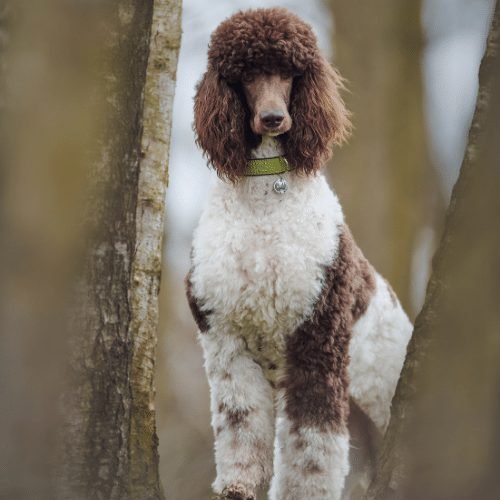When it comes to poodles, many people often picture them with their iconic curly coats in solid colors. But did you know that poodles can actually be multicolored? Yes, you heard that right! Poodles can come in a variety of colors, including combinations of different shades and patterns. This adds a unique and eye-catching flair to these already elegant and intelligent dogs.
The multicolored coat of a poodle is the result of specific genetic traits and breeding practices. Historically, poodles were bred for their retrieving abilities, and their coats were often groomed to help them swim more efficiently. Over time, breeders started experimenting with different colors and patterns, leading to the emergence of multicolored poodles. Today, there are various recognized color patterns for poodles, such as parti-colored (patches of different colors), phantom (two distinct colors), and brindle (striped pattern). This diversification in coat colors has made poodles even more appealing to potential owners, offering them a wider range of options when selecting a pet.
Yes, poodles can be multicolored. While the standard poodle breed is typically solid in color, there are other variations, such as parti poodles, which have distinct patches of different colors. These multicolored poodles can come in various combinations such as black and white, brown and white, or even apricot and white. The multicolored coat is a result of specific genetic factors. It’s important to note that multicolored poodles are still purebred poodles and can participate in dog shows and obedience trials.

The Colorful World of Poodles
Poodles are known for their elegant appearance, intelligence, and unique haircuts. They are often associated with a solid, single color coat, but can poodles be multicolored? The answer is yes! While solid colors are more common, poodles can indeed come in a variety of colors and color patterns. In this article, we will explore the fascinating world of multicolored poodles, their genetics, and the different color variations you may find in this popular breed.
Understanding Poodle Coat Genetics
To understand how poodles can be multicolored, we need to delve into the genetics of their coat color. Poodle coat color is determined by the presence or absence of specific pigments called eumelanin and pheomelanin. Eumelanin determines the darkness of the color, while pheomelanin contributes to lighter hues, such as red and cream.
Poodles have a wide range of color possibilities due to the interaction of different genes. There are three main genes that influence coat color: B (black or brown), E (extension), and S (spotting). The B gene determines whether the base color will be black or brown, the E gene controls the distribution of melanin, and the S gene affects the presence or absence of white spotting. These genes can combine in various ways, resulting in different coat color combinations.
Main Multicolored Poodle Varieties
Now let’s explore the main multicolored varieties of poodles:
Parti Poodles
Parti poodles are poodles with a predominantly white coat and large patches of another color. They can have two or three different colors, with the primary patches of color usually being black, brown, apricot, or red. Parti poodles have a striking and eye-catching appearance.
Phantom Poodles
Phantom poodles have a solid base coat color, usually black or brown, with lighter color markings on specific areas of their body. These lighter markings can be found on their eyebrows, muzzle, chest, legs, and underneath the tail. The lighter color can be any other shade, such as apricot, cream, silver, or red.
Sable Poodles
Sable poodles have a coat that starts off as a dark color at birth and progressively lightens as they grow older. This creates a unique and beautiful coat pattern. Sable poodles can have various shades of brown, cream, apricot, or silver incorporated into their coat, resulting in a stunning multi-toned appearance.
Other Color Variations
In addition to the main multicolored poodle varieties, there are several other color variations that you may come across:
Brindle Poodles
Brindle poodles have a coat pattern that features a base color with darker, irregular streaks or spots. The base color can be brown, black, silver, or another shade, and the darker streaks usually appear in a contrasting color.
Merle Poodles
Merle poodles have a coat pattern characterized by patches of lighter and darker colors mixed together. This results in a marbled or mottled appearance. Merle patterns can be found in various color combinations such as blue merle, red merle, and chocolate merle.
Tuxedo Poodles
Tuxedo poodles have a coat pattern that resembles a tuxedo, with a solid base color and a contrasting color on their chest and sometimes on their facial markings. The base color can be black, brown, silver, or another shade, while the contrasting color is typically white or cream.
Abstract Poodles
Abstract poodles have a coat pattern similar to the tuxedo poodles, but with larger patches of the contrasting color. The main difference is that the white or cream patches cover a larger part of the body, often more than 50%.
Can Poodles Be Multicolored? Absolutely!
So, can poodles be multicolored? The answer is a resounding yes! Poodles can exhibit a wide range of color variations, from parti and phantom poodles to sable and brindle poodles. The fascinating world of poodle genetics allows for these beautiful coat patterns to occur, making each poodle unique and special.
Conclusion
Poodles are not limited to one solid coat color. They can be multicolored, showcasing stunning patterns and combinations of colors. Whether you prefer the elegance of a parti poodle or the intricacy of a phantom poodle, the world of multicolored poodles offers something for every dog lover. Embrace the beauty and diversity of these multicolored poodles and enjoy the joy they bring to your life!
Can Poodles Be Multicolored? – Key Takeaways
- Yes, poodles can be multicolored with different coat patterns and markings.
- This variety of colors and patterns is due to the different combinations of genes that poodles inherit.
- Common multicolored poodle variations include parti poodles, phantom poodles, and brindle poodles.
- Each poodle’s coat is unique, making them visually striking and diverse.
- When choosing a multicolored poodle, it is important to consider the color genetics and health of the dog.
Frequently Asked Questions
Poodles are known for their elegant appearance and unique coat. One common question that many people have is whether poodles can be multicolored. In this FAQ section, we will address this topic and provide answers to some frequently asked questions about multicolored poodles.
1. Are poodles naturally multicolored?
No, poodles are not naturally multicolored. The traditional solid colors for poodles are black, white, brown, silver, gray, and apricot. However, through selective breeding and genetic variations, poodles can exhibit different coat colors that may appear multicolored. These variations are not considered the standard for poodles, but they do occur.
Some poodles can have markings or patterns on their coats, such as abstract or parti-colored patterns. These patterns can result in a combination of colors on the poodle’s coat, creating a multicolored appearance. While these variations are not recognized in show standards, they are still cherished by many poodle owners as unique and beautiful.
2. How do poodles inherit their coat colors?
The inheritance of coat colors in poodles is a complex process determined by their genetic makeup. Poodles have two sets of genes for coat color inheritance, one from each parent. These genes can carry different variations that can result in a variety of coat colors.
When breeding poodles, certain combinations of genes may result in the appearance of multicolored coats. For example, a poodle carrying the parti-color gene may produce offspring with patches or spots of different colors on their coats. However, it is important to note that breeding for specific coat color combinations should always be done responsibly and with the health and well-being of the poodles as a top priority.
3. Can multicolored poodles participate in dog shows?
In most traditional dog shows, multicolored poodles with non-standard coat colors or patterns are not eligible to compete. Dog shows typically adhere to strict breed standards, which define the acceptable colors and patterns for each breed, including poodles.
However, there are non-traditional dog shows or events specifically designed for showcasing multicolored poodles or poodles with unique coat patterns. These events celebrate the diversity and beauty of poodles with non-standard colors, providing owners with an opportunity to showcase their pets in a competitive setting.
4. How can I find a multicolored poodle as a pet?
If you are specifically looking for a multicolored poodle as a pet, it is important to find a reputable breeder who specializes in breeding poodles with unique coat colors or patterns. You can search for breeders online, visit local dog shows or events focused on non-traditional poodles, or ask for recommendations from poodle breed clubs or organizations.
When contacting breeders, make sure to ask about their breeding practices, the health and temperament of their poodles, and any genetic testing they may conduct to ensure the well-being of their dogs. Responsible breeders prioritize the health and quality of their poodles over coat color, so it’s essential to find a breeder who shares this commitment.
5. Are multicolored poodles more prone to health issues?
There is no evidence to suggest that multicolored poodles are more prone to health issues compared to poodles with standard coat colors. The health of a poodle depends on various factors, including genetics, breeding practices, and overall care and nutrition.
If you are considering getting a multicolored poodle as a pet, it is essential to choose a reputable breeder who prioritizes the health and well-being of their dogs. A responsible breeder will conduct necessary health screenings, provide proper care for the puppies, and offer guidance on how to maintain the health of your multicolored poodle throughout its life.
POODLE COLORS EXPLAINED| Do Poodles Fade?- The Truth| The Poodle Mom
In conclusion, poodles can indeed be multicolored. While the traditional image of a poodle may be a solid-colored coat, poodles can actually come in a variety of colors and patterns. These range from solid colors like black, white, and brown, to parti-colors with two or more distinct colors, and even unique patterns like phantom and brindle.
This diversity in coloration is due to the genetic makeup of poodles. They carry genes that can produce a wide range of coat colors and patterns. It is important to note that multicolored poodles are not considered any less purebred or of lesser quality than solid-colored poodles. The choice of color is simply a matter of personal preference for poodle owners.
